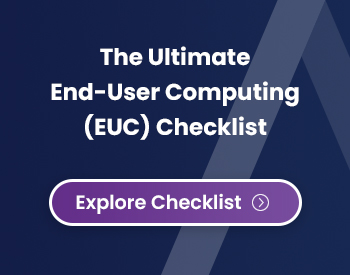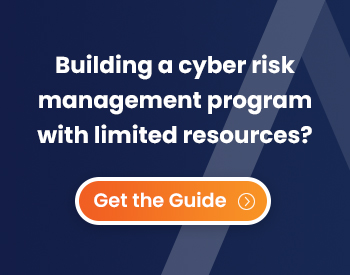Soothe sleepless nights for the risk professionals in your organization with a deeper understanding of the third-party, regulatory, and human risk they’re currently facing.
As the economy contracted this past year (and continues to contract!), organizations across the globe have been riddled with mass layoffs, budget cuts, supply chain volatility, and inflation.
Today, companies are trying to determine how to ensure business continuity and do more with less — all while facing increasing cyber-attacks, information security risks, constant geopolitical threats, and complex new regulatory frameworks. In this tumultuous environment, the responsibilities (and challenges) facing every Chief Information Security Officer (CISO) are more critical than ever.
Amidst a landscape of threats and ever-changing regulations, one question we have is: what, exactly, are CISOs and their teams losing sleep over? Let’s dive in.
 The perils of connectivity: third-party and vendor Risk
The perils of connectivity: third-party and vendor Risk
In a world of remote work, global supply chain challenges, and a growing ecosystem of vendors supporting your business, risk is no longer bound to your headquarters. In fact, according to Deloitte Global’s 2023 third-party risk management (TPRM) survey, nearly two-thirds (63%) of respondents reported that their top focus area for investment is revisiting and refreshing their overall third-party risk management (TPRM) strategy.
CISOs need to ensure that these applications and partners are proactively monitored for potential and emerging risks based on the service or products they provide, their location, and the nature of the vendor network and supply chains they rely on to deliver their services to you.
Get the Third-Party Risk Management Checklist.
 Staring into the abyss of End-User Computing (EUC) risk
Staring into the abyss of End-User Computing (EUC) risk
As employees increasingly leverage user-centered applications (like Excel, Access, Python, and other democratized tools), IT departments worry about encroaching end-user computing (EUC) risk — and for good reason. Excel remains a main site of activity, despite its limitations in sourcing data, correcting mistakes, and being shared appropriately. And even as tools emerge that could off-set spreadsheet risk, CISOs must be extra-vigilant to ensure their business’ tools do not become open pathways to bigger threats.
The challenge lies in tracking the tools employees are using, understanding how these tools constitute risk to your reputation or bottom line, and then ensuring that they are subject to the proper controls, policies, and monitoring. And in a period of increasing regulatory scrutiny around EUCs, this conversation couldn’t be more timely.
Drill into the questions that should guide your framework for defining, managing, and evidencing end-user computing (EUC) risk.
 The maze of data privacy regulations
The maze of data privacy regulations
Navigating the labyrinth of data privacy regulations presents another hurdle, especially for organizations with a global footprint. While GDPR impacts many organizations, state-specific legislation adds even more complexity. With the rise of remote work arrangements, businesses must recognize that compliance requirements extend beyond their primary location.
Companies must comply with the state laws where they are headquartered, federal law, and also every state in which they have remote employees. This entails navigating a complex web of statutes, each with their own nuances, requirements, and interpretations. Failure to comply with any of these regulations can lead to legal ramifications, fines, reputational damage — the list goes on.
Managing a workforce spread across geographic regions and states requires an ongoing effort to stay abreast of changes and nuances — and technology can help make that process less time-consuming and more compliant.
Learn more about keeping your organization’s policies compliant.
 The evolving face of human risk
The evolving face of human risk
The battle against cyber threats is continuously shifting, with phishing campaigns evolving at an alarming rate. According to Black Kite’s recent Third-Party Breach Report, almost 40% of global organizations have experienced cyber attacks in the past twelve months.
“Bad actors” — once easily detectable due to misspelled words — have leveled up. Cybercriminals leverage artificial intelligence to improve their attacks so that their emails seem more innocuous, rendering it more challenging to differentiate legitimate questions and requests from suspicious ones.
In order to adapt to this reality, CISOs and risk and compliance teams must face the music and invest in technologies that help keep your data – and your consumers – safe. In a world of change and uncertainty, companies must address new questions raised by technology with a renewed and more agile tech stack.
 Buy-in: the linchpin of Enterprise Risk Management
Buy-in: the linchpin of Enterprise Risk Management
In the quest for comprehensive risk management, gaining the support and commitment of the entire leadership team is non-negotiable. Companies of all sizes and complexities are re-evaluating and reinforcing their cyber risk management programs. But the question keeping CISOs up at night is: how do you build mature cyber security programs within your business while facing budget constraints and workforce reductions? How can you get buy-in from your Board if there is a lack of critical know-how regarding the evolving threatscape and its potential impact?
The answer is to align your cyber risk management roadmap with your organization’s core objectives (and bottom line) — and we gathered the expert’s advice for how to do so on a limited budget.
Helping CISOs rest easy
Nights don’t need to be sleepless for CISOs; strategic integration of technology and a united leadership front can help keep your risk department one step ahead of governmental regulation updates, cyberthreats, and the uncertainties of change management within a team or organization.
One proven way to handle a broad spectrum of risk is to focus not on siloed, disparate solutions, but on an integrated risk management strategy.
As we grapple with a shifting landscape, one thing is certain: the role of the CISO has never been more pivotal, and the strategies employed today will shape the security landscape for the challenges of tomorrow. Rest assured, the night might be long, but with the right tools and strategies, the dawn of security is inevitable.
Our focus? On your success.
Schedule a demo, or learn more about Mitratech’s products, services, and commitment.




